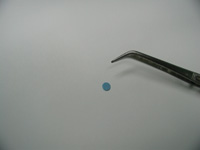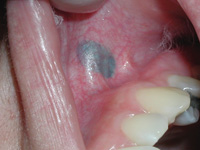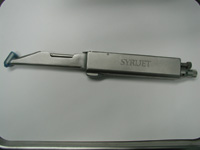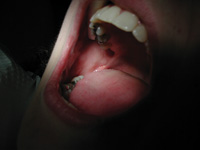Dental patients’ fear of pain caused by injections of local anesthetic in the course of treatment is a major obstacle to dentists successfully providing such treatment.1 Minimizing the discomfort attendant to the process of infiltration and block injections can be focused on two aspects of these injections: needle penetration into soft tissue, and the development of pressure within soft tissue as the anesthetic solution is infused.2 Both elements can contribute to the pain experienced by patients from injections administered during routine dental treatment. The latter issue relates to the accrual of pressure within soft tissue as the volume of anesthetic increases. The sensitivity generated by this pressure may be pre-empted by carefully controlling the concentration of anesthetic infusion.3 How this may be best achieved is unclear,4,5 but it would appear that both traditional and newer techniques are effective if practiced assiduously. Personally, I use a conventional syringe injecting a carpule over 60 to 90 seconds with what my patients tell me are excellent results. Topical anesthesia focuses on the former problem, and is the subject of this article.
Topical anesthetics used prior to infiltration and block injections for dental treatment commonly come in the form of sprays, liquids, or gels. The clinical efficacy of these agents in averting discomfort on needle penetration is questionable at best, with notably little difference between these agents, tissue vibration (“cheek tugging”) with or without concomitant topical anesthetic use, and even placebo.6-8 Even the use of electronic anesthesia as a topical agent produces comparatively insignificant reductions in pain on needle penetration.2
I believe that it is the form in which the majority of topical anesthetics are applied, and to some degree their composition, that accounts for the relative inadequacy of most topical agents. A principal factor in the effectiveness of topical anesthetics is tissue penetration.9 While not allowing adequate time for diffusion of the topical anesthetic into the mucosa is a mistake often made by practitioners, poor localization and retention of the agent on the soft tissue can negatively affect its success, as well.10 The oral cavity pre-sents considerable challenges with respect to these parameters because salivary flow and pooling can be a hindrance to these objectives. This is evidenced by the fact that topical efficiency on the mandible is relatively higher in the mucobuccal fold area for mental blocks than at the pterygo-mandibular raphe for inferior alveolar blocks, where a greater accumulation of saliva could be expected.11 While this is not the only issue relating to the pain associated with these blocks, it is a key one.
Some agents have been convincingly shown to almost eliminate needle insertion pain.12 From personal experience, I know the Denti-Patch (Noven Pharmaceuticals) to be a highly efficacious topical agent if given sufficient time to act. It uses a fairly high concentration of lidocaine in an adhesive patch that clings firmly when applied to attached soft tissue, allowing targeted dispersion of the active ingredient. Adhesive patches and cellulose discs would seem to be more successful vehicles in terms of maintaining and concentrating the topical agent at the intended site.10
 |
 |
| Figure 1. Anaesthesie Tab 5-mm cellulose disc. | Figure 2. Blue “bull’s eye” left by Anaesthesie Tab to mark the site of injection. |
 |
 |
| Figure 3. The Syrijet anesthetic injector. | Figure 4. Red macule marks the spot where anesthesia has entered. |
It also appears that some anesthetic agents have a greater potential than others to be correlated with a higher level of topical anesthesia. Tetracaine hydrochloride and dibucaine hydrochloride are among the most potent in this regard.13 Both of these anesthetics can be found in Anaesthesie Tabs (Voco, Germany), which are cellulose discs about 5 millimeters in diameter (Figure 1) that leave a blue “bull’s eye” on the tissue upon removal, to mark the eventual injection site (Figure 2). Gently extend the mucosal surface taut and insert your needle into the center of the bull’s eye. I have been using these tabs for several years now and have found them to be just as effective as the Denti-Patch, while being more cost-effective on a per-injection basis. They reach full effect in 90 to 120 seconds, and the blue marking disappears a few hours after use. They have a somewhat higher-than-average rate of allergic contact dermatitis,14 but it has been my experience that most patients comment on the appearance of this reaction more than any related sensations.
The tabs are effective in any mucobuccal fold where they can be held in place with a cotton roll. It is critical that enough time be allowed to elapse after the tab has been inserted before the injection is attempted, or the full effects possible with this product will not be realized. I use the Anaesthesie Tabs for all injections save for inferior alveolar blocks and palatal infiltrations. For the latter, I use the transpapillary technique following a buccal infiltration.15 At the pterygo-mandibular raphe, of course, there is no fold, and until the year 2000 I had used gels, liquids, and sprays with erratic success at best. Then I discovered the Syrijet (Keystone Industries). The Syrijet (Figure 3) is a needleless, jet anesthetic injector that I have found provides excellent topical and, more importantly, subtopical anesthesia for inferior alveolar blocks. To deposit the contents of a carpule of anesthetic at the lingula for inferior alveolar blocks, needle penetration must reach significantly greater depths into soft tissue than with an infiltration injection in most instances. The subtopical anesthesia that the Syrijet provides is ideal for this purpose.16 The breadth and depth of anesthetic penetration achieved with this device17 gives the dentist wide latitude to manipulate the cannula in the soft tissue with little or no patient discomfort. Typical of the comments I have heard when using this procedure, one of my patients remarked to me that she did not feel the needle insertion, “any of the way in.” Standard dental carpules may be used in the Syrijet with jet volumes up to 0.20 cc having been shown to be well tolerated by dental
patients, even children.16,18
First, place a cotton roll in the mucobuccal fold of the upper arch on the side where you will be working for moisture control, have the patient open as wide as possible, and dry the pterygo-mandibular raphe with your suction. Now place the injector head’s nozzle (arrow) snugly against the tissue where you will be injecting, and press the trigger. A red macule (Figure 4) will then appear on the tissue surface where the jet of anesthetic entered. Use this as the target point for your injection.
I use a 0.05-cc volume of articaine hydrochloride in my Syrijet and wait 2 to 3 minutes before performing the inferior alveolar block injection, to allow for full efficacy. Again, allowing sufficient time for complete effect is crucial. I use this small volume of articaine hydrochloride because that anesthetic’s chemical composition affords it a greater solubility in lipids,19 which increases its penetration into fatty tissues. Also, unlike other anesthetics reported to cause a burning sensation on immediate infusion,20 I have heard no such complaints from my patients with this one. Even though using the same carpule on multiple patients in the Syrijet should present a minimal risk of cross-infection,21 I always use one carpule for one patient. After using the Syrijet, I remove the articaine carpule and place it in my traditional syringe for the block, as articaine has been observed to be more effective in these injections because of its aforementioned chemical characteristics.22 In my office, the rubber sheaths supplied with the Syrijet that cover its injector head are always changed between patients and sterilized after each use. I also prime the Syrijet with a carpule of distilled water before each patient use, even though the manufacturer only recommends this on a weekly basis. Priming is imperative as crystalline residue from anesthetics can clog the Syrijet after repeated use.
CONCLUSION
I have always felt that if when providing a patient with dental treatment I cause that patient discomfort such that he or she becomes apprehensive about future treatment, I have failed that patient. Discomfort from administration of local anesthesia is a significant source of such apprehension.1 I have found that the use of the methods and materials described in this article greatly minimizes the patient’s discomfort from, and therefore fear of, local anesthetic injections. This is a practice builder that will reduce the doctor’s stress level, promote patient loyalty, and increase case acceptance. It is important to remember that when providing local anesthesia, as in most other phases of direct patient care, it is deeply appreciated when doctors really take the time to make their patients comfortable.
References
1. Glassman P, Peltier B. Guidelines for the administration of local anesthesia in fearful dental patients. J Calif Dent Assoc. 1995;23:23-26.
2. Quarnstrom F, Libed EN. Electronic anesthesia versus topical anesthesia for the control of injection pain. Quintessence Int. 1994;25:713-716.
3. Hochman M, Chiarello D, Hochman CB, et al. Computerized local anesthetic delivery vs. traditional syringe technique. Subjective pain response. NY State Dent J. 1997;63:24-29.
4. Krochak M, Friedman N. Using a precision-metered injection system to minimize dental injection anxiety. Compend Contin Educ Dent. 1998;19:137-143.
5. Goodell GG, Gallagher FJ, Nicoll BK. Comparison of a controled injection pressure system with a conventional technique. Oral Surg Oral Med Oral Pathol Radiol Endod. 2000;90:88-94.
6. Kinchloe JE, Mealiea WL Jr, Mattison GD, Seib K. Psychophysical measurement on pain perception after administration of topical anesthetic. Quintessence Int. 1991;22:311-315.
7. Martin MD, Ramsay DS, Whitney C, et al. Topical anesthesia: differentiating the pharmacological and psychological contributions to efficacy. Anesth Prog. 1994;41:40-47.
8. Hutchins HS Jr, Young FA, Lackland DT, Fishburne CP. The effectiveness of topical anesthsia and vibration in alleviating the pain of oral injections. Anesth Prog. 1997;44:87-89.
9. Maddi R, Horrow JC, Msrk JB, et al. Evaluation of a new cutaneous topical anesthsia preparation. Reg Anesth. 1990;15:109-112.
10. Holst A, Evers H. Experimental studies ofnew topical anesthetics on the oral mucosa. Swed Dent. 1985;9:185-191.
11. Nakanishi O, Haas D, Ishikawa T, et al. Efficacy of mandibular topical anesthesia varies with the site of administration. Anesth Prog. 1996;43:14-19.
12. Houpt MI, Heins P, Lamster I, Stone C, Wolff MS. An evaluation of intraoral lidocaine patches in reducing needle insertion pain. Compend Contin Educ Dent. 1997;18:309-310.
13. Yokoyama S. Correlation between pharmacological potency and micellar surface potential of local anesthetic. Toxicol Lett. 1998;100-101:365-368.
14. Amano K. [Clinical study of patients with positive reactions in patch tests with local anesthetics]. Nippon Ika Daigaku Zasshi. 1997;64:139-146.
15. McArdle BF. Painless palatal anesthesia. J Am Dent Assoc. 1997;128:647.
16. Greenfield W., Karpinski JF. Needleless Jet injection in comprehensive pain control and applications to oral surgery. Anesth Prog. 1972;19:94-97.
17. Bennett CR, Mundell RD, Monheim LM. Studies on tissue penetration characteristics produced by jet injection. J Am Dent Assoc. 1971;83:625-629.
18. Saravia ME, Bush JP. The needleless syringe: efficay of anesthesia and patient preference in child dental patients. J Clin Pediatr Dent. 1991;15:109-112
19. Malamed SF, Gagnon S, Leblanc D. Articaine hydrochloride: a study of a new amide local anesthetic. J Am Dent Assoc. 2001;132:177-185.
20. Strupp W. A clinical Technique for giving painless injections. Dent Today. 1998;17:34-37.
21. Suria H, Van Enk R, Gordon R, Mattano LA Jr. Risk of cross-patient infection with clinical use of a needleless injector device. Am J Infect Control. 1999;27:444-447.
22. Friedman MJ. New advances in local anesthesia. Compend Contin Educ Dent. 2000;21:432-440.
Dr. McArdle is cofounder of the Seacoast Esthetic Dentistry Association (SEDA) (www.dentalesthetics.org) and is on the Board of Directors of Priority Dental Health, Inc (www.prioritydental.com). Visit his website at www.mcardledmd.com.


